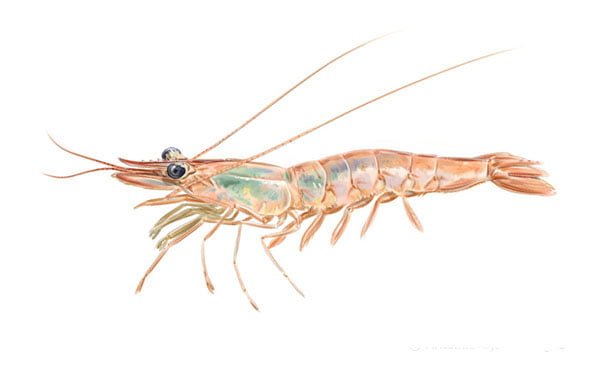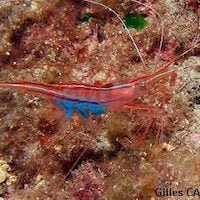Plesionika Narval
– Narwal Shrimp –



Description
Plesionika narwal is a slender-bodied shrimp, exceptionally reaching 10 cm in length without the rostrum *, but on average it does not exceed 7 to 8 cm . Males are slightly smaller than females.
The body is more or less translucent orange-pink in color with a longitudinal red line bordered with white starting from the tail running along the sides and ending at eye level. An other line, also flanked by white , from the top of the queue, is divided into two along the back of each side meets the head to extend to the end of the rostrum. The rostrum is 1.5 to 2.7 times the length of the shell. It has very many small teeth on its upper face (40 to 73) and on its underside (26 to 60). The eyes are blue gray, large, pedunculate * and set perpendicular to the head. The antennae, often white in color, are up to 3 times the length of the body and are usually curved like a whip and directed backwards. The antennae, bifid *, are shorter and white in color .
The legs are the same color as the body. They are thin , increasingly long, the former being the shortest.
Biotope
This gregarious species is generally found between 100 and 400 m deep on muddy, sandy or sandy-muddy bottoms but it has been observed up to 910 m. It also frequents dark, shallow caves from ten meters below the surface. At night she can leave the caves and venture outside, staying in a compact bench.
Similar Species
The genus Plesionika contains many species that also live at great depths, but the livery of P. narwhal is unique.
On the metropolitan coasts, Lysmata seticaudata is a red shrimp with, by day, a few longitudinal white and red lines and at night 6 red transverse bands and has also red antennae. The rostrum is very short and it is much more massive in shape.
Alimentation
The narwhal shrimp are an active predator of small planktonic crustaceans * but they also sometimes play the role of scavengers.
Reproduction
The biology of Plesionika narwhal is poorly understood, but it is likely that the sexes are separated at birth. For some it would be a hermaphrodite * protander * species. Further studies would be necessary to decide. Females are ovigerous * all year round but the majority of reproduction takes place between August and November. They are adults around 1 year and a half when they reach about 7 cm in carapace length. The eggs (0.4 x 0.5 mm) are blue in color and carried under the abdomen. A 6.5 cm female can carry up to a thousand eggs. The larvae * and the young have a pelagic * life. There are 5 larval stages and a post-larval stage (decapodite).
Various Biology
This species generally lives in large schools of several hundred or thousands of individuals composed of approximately 70% females and 30% males. In the caves, the school does not remain in swarm in open water, on the contrary, the narwhal shrimps spread out and line the walls giving the strange impression to the diver that the walls are moving!
Further Information
Narwhal shrimp life expectancy is around 7 years, but most schools are made up of individuals under 3 years old.
This species is of commercial importance especially in Madeira, the Canaries and the Mediterranean where it is fished. Juveniles are caught in open water with pelagic nets, while adults are harvested on the bottom by trawling or with traps.










































































































































































































































































































































































